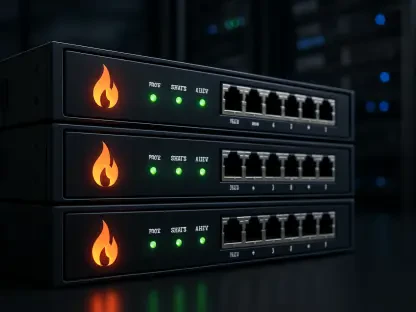In today’s rapidly shifting cybersecurity landscape, organizations face an unprecedented array of threats, from polymorphic malware to advanced persistent threats (APTs) and zero-day exploits, making the selection of a Next-Generation Firewall (NGFW) provider a pivotal decision for network protection. Traditional firewalls, once sufficient for basic traffic filtering, now struggle to keep pace with the sophisticated attacks that define the digital era. NGFWs have emerged as a critical solution, offering advanced capabilities such as deep packet inspection, granular application control, and integrated threat prevention to address the complexities of modern IT environments, including widespread cloud adoption and the rise of remote workforces. As businesses across scales—ranging from small to medium-sized enterprises (SMBs) to large corporations and managed service providers (MSPs)—grapple with securing their networks, the choice of an NGFW provider becomes not just a technical decision but a strategic one. This article aims to dissect the offerings of leading providers, evaluating their strengths, innovations, and suitability for diverse needs. By delving into market trends and specific vendor capabilities, the goal is to provide clarity on which provider stands at the forefront of network security, ensuring organizations can safeguard their digital assets against ever-evolving cyber risks with confidence and precision.
The Growing Necessity of Advanced Firewalls
The urgency for robust network security solutions has never been more pronounced, as cyber threats have evolved far beyond the capabilities of traditional firewalls to contain them. Attacks such as ransomware, phishing, and APTs exploit vulnerabilities in ways that demand a multi-layered defense strategy. NGFWs meet this challenge head-on by incorporating features like intrusion prevention systems (IPS), anti-malware defenses, web filtering, and sandboxing for analyzing unknown threats. These tools enable organizations to detect and mitigate risks in real time, protecting critical data from breaches that could have devastating financial and reputational consequences. Beyond merely blocking unauthorized access, NGFWs provide a comprehensive shield that adapts to the dynamic nature of cyber threats, ensuring businesses can operate without constant fear of compromise.
Another critical aspect driving the adoption of NGFWs is the need for application visibility and control in an era dominated by Software-as-a-Service (SaaS) platforms. With employees increasingly relying on cloud-based applications, the risk of shadow IT—unauthorized apps running on corporate networks—has surged, creating potential entry points for attackers. NGFWs address this by allowing IT teams to set granular policies that dictate which applications can operate and under what conditions. This capability not only reduces vulnerabilities but also enhances productivity by ensuring resources are allocated to approved tools, thereby maintaining operational efficiency while tightening security across distributed environments.
Emerging Trends in Network Security Solutions
One of the most significant shifts in the NGFW market is the convergence of networking and security functionalities into unified platforms. Many providers now integrate SD-WAN capabilities alongside traditional firewall features, catering to distributed enterprises that require seamless connectivity and protection across multiple branch offices or remote locations. This trend reflects a broader demand for solutions that optimize both network performance and security posture, eliminating the need for disparate systems that can introduce complexity and gaps in defense. As organizations expand their digital footprints, this integration ensures consistent policy enforcement and visibility, regardless of where data or users reside.
Equally transformative is the incorporation of artificial intelligence (AI) and machine learning (ML) into NGFW solutions, revolutionizing how threats are detected and addressed. These technologies enable firewalls to identify unknown malware and other anomalies with greater speed and accuracy, often before they can cause harm. Automated response mechanisms further enhance this by neutralizing threats without human intervention, a critical advantage in fast-paced attack scenarios. As cybercriminals leverage increasingly sophisticated tactics, the ability of NGFWs to learn from patterns and adapt to new risks positions them as indispensable tools for staying ahead of the curve in network defense strategies.
Spotlight on Leading NGFW Providers
Palo Alto Networks often emerges as a frontrunner in the NGFW arena, celebrated for its exceptional threat prevention and unparalleled visibility into user and application behavior. Its flagship features, such as the WildFire cloud-based threat analysis service, provide real-time protection against unknown threats, while App-ID and User-ID enable precise control over network activity. Integration with broader security ecosystems like Prisma SASE further solidifies its appeal for large enterprises with complex requirements. However, the high cost and intricate management associated with these solutions may pose challenges for smaller organizations, positioning Palo Alto Networks as a premium choice for those prioritizing cutting-edge security over budget constraints.
Fortinet, with its FortiGate line, offers a compelling blend of high performance and value, driven by custom security processing units that ensure rapid threat processing. The inclusion of built-in SD-WAN capabilities makes it a standout for organizations seeking to merge networking and security into a single platform. While the broader Fortinet Security Fabric provides a robust ecosystem for scalability, managing its full suite can be daunting, and some advanced features require additional licensing. This makes Fortinet particularly suitable for businesses that value performance and are willing to invest time in navigating its comprehensive offerings for maximum benefit.
Sophos distinguishes itself through a synchronized security model, linking its firewalls with endpoint protection for automated threat responses via Sophos Heartbeat. This approach, combined with deep learning for threat detection and centralized management through Sophos Central, delivers ease of use and affordability, ideal for SMBs. However, the full strength of its synchronized security is realized only when paired with Sophos endpoints, and it may not scale as effectively for the largest enterprises. Sophos thus caters to organizations seeking integrated, user-friendly solutions without the complexity of enterprise-grade systems.
Deeper Insights into Key Players
Cisco Secure Firewall, leveraging the company’s extensive networking expertise and Talos threat intelligence, provides a threat-centric approach with strong application visibility and advanced malware protection. Its integration into the Cisco SecureX platform ensures unified security for organizations with existing Cisco infrastructure, offering scalability for large deployments. Despite these strengths, the complexity of management and higher cost structure can be barriers for smaller entities lacking dedicated IT resources. Cisco remains a go-to for enterprises that prioritize reliability and deep integration within a familiar technological framework, ensuring robust defense across sprawling networks.
Check Point adopts a prevention-first philosophy with its Quantum Security Gateways and CloudGuard platform, featuring tools like SandBlast for zero-day threat defense. The Infinity architecture ensures consistent security across network, cloud, and endpoint environments, managed through the SmartConsole. While highly effective for hybrid setups, the expense and steep learning curve of its solutions target larger enterprises with the capacity to invest in top-tier protection. Check Point excels for those needing uncompromising security and unified management, particularly in environments where advanced threats are a constant concern.
Juniper Networks offers a unique proposition with its SRX Series, combining security with high-performance routing on the Junos OS. This makes it ideal for demanding environments where network performance cannot be sacrificed for security. Features like advanced threat prevention and SD-WAN integration are complemented by centralized management through Security Director, though configuration complexity may deter less experienced teams. Juniper suits large enterprises and service providers that require a seamless blend of networking prowess and security resilience in their operations.
Niche Innovators and Targeted Solutions
Forcepoint brings a human-centric security model to the table, focusing on user behavior and data flow rather than just perimeter defense. Its scalable multi-link SD-WAN capabilities cater to distributed networks, while centralized management supports policy enforcement across thousands of firewalls. Though less prominent than some market leaders, Forcepoint offers a compelling option for organizations with remote workforces, prioritizing high availability and user-focused protection. Its approach addresses the unique challenges of modern, decentralized work environments, ensuring data remains secure regardless of location.
WatchGuard’s Firebox NGFWs strike a balance between enterprise-grade features and simplicity, making them accessible to mid-sized businesses and MSPs. Managed through WatchGuard Cloud or on-premises tools, they include secure Wi-Fi and SD-WAN options, delivering comprehensive security at a reasonable cost. While scalability for the largest enterprises may be limited, and some features require add-ons, WatchGuard excels for those seeking manageable, value-driven solutions. This focus ensures smaller organizations can access robust protection without the overhead of overly complex systems.
SonicWall targets SMBs and distributed enterprises with its TZ and NSa series, featuring patented Reassembly-Free Deep Packet Inspection technology and Capture Advanced Threat Protection for zero-day defense. Its solutions are affordable and easy to manage, though performance on lower-end models can falter when all features are enabled. SonicWall fits organizations with constrained budgets that still require effective security, offering a practical entry point into NGFW capabilities without sacrificing essential protections against prevalent threats.
Sangfor, a notable player particularly in the Asia-Pacific region, introduces AI-driven threat detection and integrated web application firewall capabilities into its high-performance NGFWs. While innovative and strong in consolidated security platforms, its lesser recognition and support availability in Western markets may limit its appeal for global firms. Sangfor stands out for enterprises in specific regions or those prioritizing AI-powered defenses, providing a forward-thinking approach to tackling sophisticated cyber risks in targeted markets.
Navigating Choices for Optimal Security
The NGFW market showcases remarkable diversity, with providers like Palo Alto Networks and Check Point setting benchmarks for enterprise-grade threat prevention and ecosystem integration, while others like SonicWall and WatchGuard focus on accessibility for SMBs. This spectrum ensures that organizations, regardless of size or complexity, can find a solution tailored to their specific security and operational needs. Factors such as the depth of threat prevention, ease of management, and integration with existing infrastructure often dictate the most suitable choice, highlighting the importance of aligning vendor strengths with organizational priorities.
Beyond individual provider capabilities, the broader shift toward integrating AI, unified management, and networking features like SD-WAN signals a maturing market ready to tackle the multifaceted challenges of cybersecurity. Decision-makers must weigh these advancements against practical considerations like budget and IT team expertise to ensure the chosen NGFW not only addresses current threats but also scales with future demands. By carefully evaluating these elements, businesses can position themselves to navigate the digital landscape with resilience, knowing their networks are fortified by a provider that matches their unique risk profile and strategic goals.
Reflections on the Path Forward
Looking back, the exploration of leading NGFW providers revealed a dynamic field where innovation and specialization have driven significant advancements in network security. Each vendor, from Palo Alto Networks’ comprehensive threat prevention to Sangfor’s AI-driven approaches, has contributed to a landscape rich with options for combating sophisticated cyber threats. The integration of networking and security, alongside user-centric and cloud-adapted solutions, has redefined how organizations protect their digital assets in an increasingly complex environment.
Moving forward, the focus should shift to actionable strategies, such as conducting thorough assessments of organizational needs before selecting an NGFW provider. Prioritizing scalability and compatibility with existing systems can prevent future bottlenecks, while staying informed about emerging technologies like AI enhancements will ensure defenses remain cutting-edge. Engaging with vendors for tailored demonstrations or pilot programs could further clarify which solution best aligns with specific security goals. Ultimately, the journey to robust network protection lies in leveraging these insights to build a resilient framework that evolves alongside the ever-changing threat landscape.









